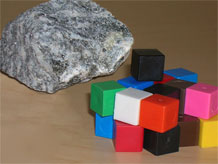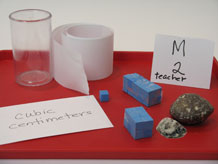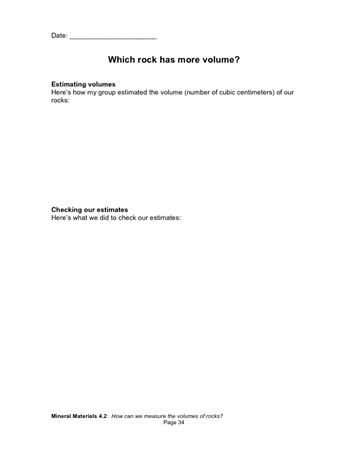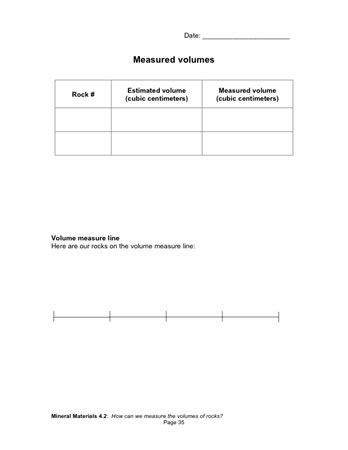How can we measure the volumes of rocks?
Plan Investigation 4.2

The students are getting good at measuring different kinds of earth materials. They can weigh rocks and minerals and cubes with ease using the digital scale. They can measure the volume of liquid samples using their own "measuring cups." But how can they measure the volume of an irregularly shaped solid, like a key or a rock or a handful of sand?
Formative Assessment
Available online at inquiryproject.terc.edu
A clue can be found in the last investigation. Students discovered that when a rock is submerged in water, it displaces a "rock's worth" of volume. In this investigation, students find a way to measure that volume in cubic centimeters. By the end of the investigation students will understand that the volume of solid objects can be found by measuring the amount of water they displace.
Learning Goals
- Recall that volume is measured in cubic centimeters
- Understand that the volume of a solid object can be found by water displacement
| Sequence of experiences | ||
|---|---|---|
| 1. Ask the question | All Class | 15 Mins |
| 2. Estimate and measure the volume of rocks | Small Groups | 15 Mins |
| 3. Share the volume data | Small Groups | 5 Mins |
| 4. Discuss the results | Discussion | 10 Mins |
Materials and Preparation

For the class:
- Post the investigation question in a place where all students can see it.
- 1 classroom volume measure line (see kit for instructions)
- 1 12cc rectangular block made by joining 12 centimeter cubes in a 2x2x3 shape (use clear tape).
- 1 20cc rectangular block made by joining 20 centimeter cubes in a 2x2x5 shape (use clear tape).
- 1 centimeter cube
- 1 empty 150cc container
- 2 rocks or minerals of different sizes

For each tray:
- 2 rocks or minerals
- 1 cup holding approximately 75 centimeter cubes
- 4 150cc containers each with a vertical strip of masking tape applied to the outside, approximately half full of water
- 1 3oz cup of water
- 2 pipettes
- 1 fine tip permanent marker
- 2 paper towels
- 1 plastic fork
Do students understand that a collection of centimeter cubes equal to the volume of a rock will displace an equal amount of water?
For evidence, observe students as they work, listen to their conversation with peers, ask questions, e.g., “Would you tell me about what you are doing?”
To interpret the evidence, ask yourself; Does this student:
- Begin with equal volumes of water?
- Compare the water level of the rock and cubes and note that when the water levels are equal, the number of cubes are equal to the volume of the rock?
- Count the number of cubes and describe the volume of the rock in cubic centimeters?
A possible next step would be to ask students to use props or drawings to describe what they did, why they did it, and what they found out.










